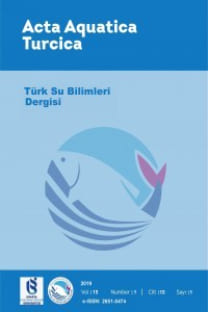Tatlısu Midyesi Unio Terminalis’te Bakırın 96 Saatlik LC50 Değeri ile Birikim Düzeylerinin Belirlenmesi
Bu çalışmada tatlı su midyesi Unio terminalis’te eser ağır metallerden bakırın 96 saatlik LC50 değeri ile 96 saatlik LC50 değerinin %25, %50 ve %100’ne karşılık gelen derişimlerinin 96 saat süreyle etkisinde total birikim düzeylerinin belirlenmesi amaçlanmıştır. Midye örneklerinin bakır analizinde ICP-MS kullanılmıştır. U. terminalis’te bakırın 96 saatlik LC50 değeri 4.65 ppm olarak belirlenmiştir. Daha sonra midyeler 96 saat süreyle, bakırın bu derişimin %25, %50 ve %100’ne karşılık gelen 1, 2 ve 4 ppm’lik derişimlerinin etkisinde bırakılmış ve deney süresi sonunda total birikim düzeyleri sırasıyla 56 µg Cu/g k.a., 77 µg Cu/g k.a. ve 28 µg Cu/g k.a. olarak tespit edilmiştir. İncelenen tüm derişimlerin etkisinde, birikim düzeylerinin kontrol grubuna oranla önemli düzeyde artış gösterdiği saptanmıştır. 1 ve 2 ppm’lik derişimlerin etkisindeki birikim düzeyleri, incelenen yüksek derişimin etkisindeki birikime oranla daha fazla olmuştur
Anahtar Kelimeler:
Bakır, LC50, Birikim, Unio terminalis, Tatlısu Midyesi
Determination of 96 h LC50 Value of Copper and Its Total Body Accumulation during the Same Perod in Unio terminalis
In this study, Unio terminalis was exposed to 25%, 50% and 100% of its 96 h LC50 value of copper over 96 hours after determining the 96 h LC50 value for this metal. The 96 h LC50 value of copper to this species was determined as 4.65 ppm Cu and hence the species was exposed to 1.0, 2.0 and 4.0 ppm Cu for 96 hours. Tissue analysis of copper was carried out using ICP-MS techniques. Total body accumulation of copper were 56 µg Cu/g d.w., 77µg Cu/g d.w. and 28µg Cu/g d.w. for 1.0, 2.0 and 4.0 ppm Cu exposures respectively after 96 hours. Copper levels were significantly higher in animals exposed to copper compared with the control. Accumulation of copper, however, was lower at the highest Cu concentration tested compared the lower concentrations.
Keywords:
Copper, LC50, Accumulation, Unio termialis, Freshwater mussel,
___
- Allen, D.C., ve Vaughn, C.C. (2011) Density-dependent biodiversity effects on physical habitat modification by freshwater bivalves, Ecology, 95: 1013–1019.
- Başçınar, N.S., Düzgüneş, E., Mısır, D.S., Polat, H., Zengin, B. (2009) Growth and Flesh Yield of the Swan Mussel (Anodonta cygnea (Linnaeus, 1758)) (Bivalvia: Unionidae) in Lake Çıldır (Kars, Turkey), Turkish Journal of Fisheries and Aquatic Sciences, 9: 127-132.
- Cherry, D.S., Van Hassel, J.H., Farris, J.L., Soucek, D.J., Neves, R.J. (2002) Site Specific Derivation of the Acute Copper Criteria for the Clinch River Virginia,.Human and Ecological Risk Assessment, 8(3):591-601.
- Cummings, K.S,.ve Mayer, C.A. (1992) Field Guide to Freshwater Mussels of the Midwest.Illinois, Natural History Survey Manual 5,194 pp.
- Eisler, R. (1977) Acute toxicities of selected heavy metals to the softshell clam, Mya arenaria, Bull. Environ. Contam. Toxicol., 17:137-145.
- Eisler, R. (1995) Electroplating wastes in marine environments: a case history at Quonset Point, Rhode Island. Pages 539-548 in D.J. Hoffman, B.A. Rattner, G.A. Burton, and J. Cairns, Jr. (eds.). Handbook of Ecotoxicology.Lewis Publishers, Boca Raton, FL.
- Grabarkiewicz, J.D., ve Davis, W.S. (2008) An Introduction to Freshwater Mussels as Biological Indicators, U.S.Environmental Protection Agency, 108 p.
- Graf, D.L., ve Cummings, K.S. (2007)Review of the systematics and global diversity of freshwater mussel species (Bivalvia:Unionoida), Journal of Molluscan Studies, 73:291-314.
- Harrison, F.L., Knezovich, J.P., Rice, D.W. (1984) The Toxicity of Copper to the Adult and Early Life Stages of the Freshwater Clam, Corbicula manilensis, Arch. Environ.
- Contam. Toxicol. 13, 85-92. International Union for Conservation of Nature (IUCN) (2014) http://www.iucnredlist.org/details/164866/0.
- Jacobson, P.J., Farris, L.J., Cherry, D.S, Neves. R.J. (1993) Juvenile freshwater mussel (Bivalvia: Unionidae) responses to acute toxicity testing with copper, Environ. Toxicol. Chem., 12:879-883.
- Jacobson, P.J., Farris, J.L., Neves, R.J., Cherry, D.S. (1997) Sensitivity of Glochidia Stages of Freshwater Mussels to Copper,.Journal of Aquatic Toxicology,16:2384-2392.
- Kara, C. (2004) Gavur Gölü (Kahramanmaraş)’nde Yaşamış Olan Unio pictorum(L., 1758)’un Bazı Biyolojik Özellikleri, KSU. Journal of Science and Engineering, 7(2).
- March, F.A., Dwyer, F.J., Augspurger, A., Ingersoll, C.G., Wang, N., Mebane, C.A. (2007) An evaluation of freshwater mussel toxicity data in the derivation of water quality guidance and standards for copper, Environmental Toxicology and Chemistry, 26(10):2066-2074.
- Milam, C.D., Farris, J.L., Dwyer, F.J., Hardesty, D.K. (2005) Acute toxicity of six freshwater mussel species (glochidia) to six chemicals:implications for daphnids and Utterbackia imbecillisas surrogates for protection of freshwater mussels (Unionidae),.Archives of Environmental Contamination and Toxicology, 48(2):166-173.
- Muramoto, S., (1983) Elimination of Copper from Cu-Contaminated Fish by Long Term Exposure to EDTA and Freshwater, J. Environ. Sci. Health, A18(3):455-461. Naimo, T.J. (1995) A review of the effects of heavy metals on freshwater mussels, Ecotoxicology 4,341-362.
- Öktener, A. (2004) Sinop Ve Bafra’da Bazı Tatlısulardaki mollusca Türleri Üzerine Bir Ön Araştırma, G.U. Journal of Science, 17(2):21-30.
- Pip, E. (2006) Littoral mollusc communities and water quality in southern Lake Winnipeg, Manitoba, Canada.Biodiversity and Conservation, 15(11):3637-3652. Puente, X., Villares,R., Carral, E., Carballeira, N. (1996) Shell of Mytilus galloprovincialis as a biomonitor of heavy metal pollution in Galiza (NW Spain). The Sci. Total Environ. 183, 205-211.
- Vaughn C.C., Nichols S.J., Spooner, D.E. (2008) Community and foodweb ecology of freshwater mussels, J N Am Benthol Soc, 27: 409–423.
- Wang, N., Ingersoll, C.G., Greer, I.E., Hardesty, D.K., Ivey, C.D., Kunz, J.L., Brumbaugh, W.G., Dwyer, F.J., Robers, A.D., Augspurger, T., Kane, C.M., Neves, R.J., Barnhart, MC. (2007) Assessing contaminant sensitivity of early life stages of freshwater mussels (Unionidae):Acute toxicity testing of copper, ammonia, and chlorine to glochidia and juvenile mussels Environmental Toxicology and Chemistry, 38pp
- Yayın Aralığı: Yılda 4 Sayı
- Başlangıç: 1988
- Yayıncı: Yunus Ömer BOYACI
